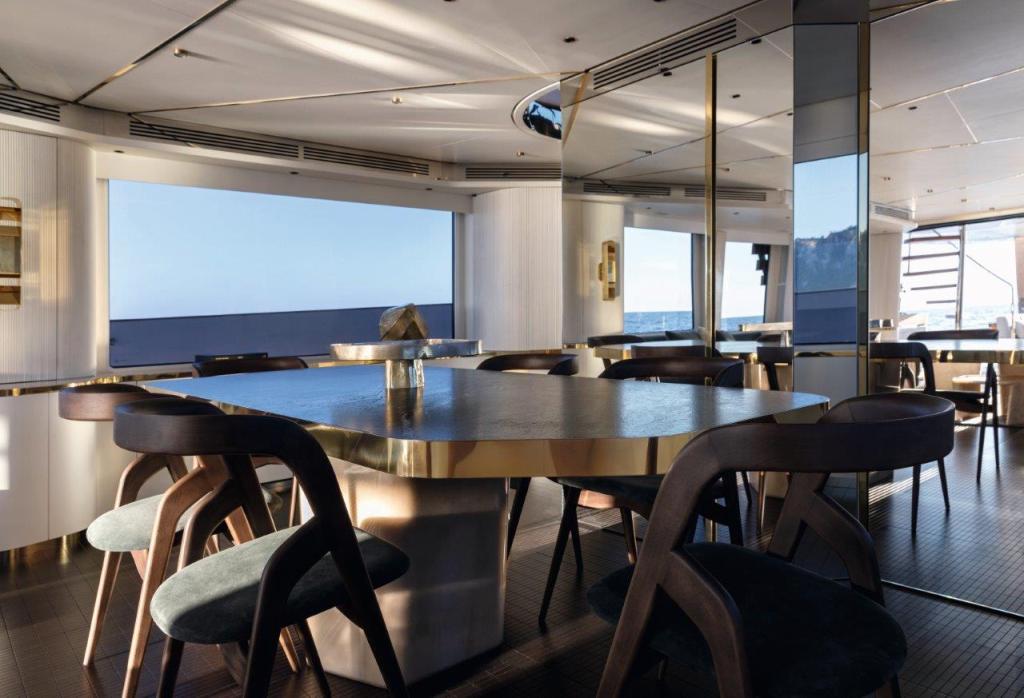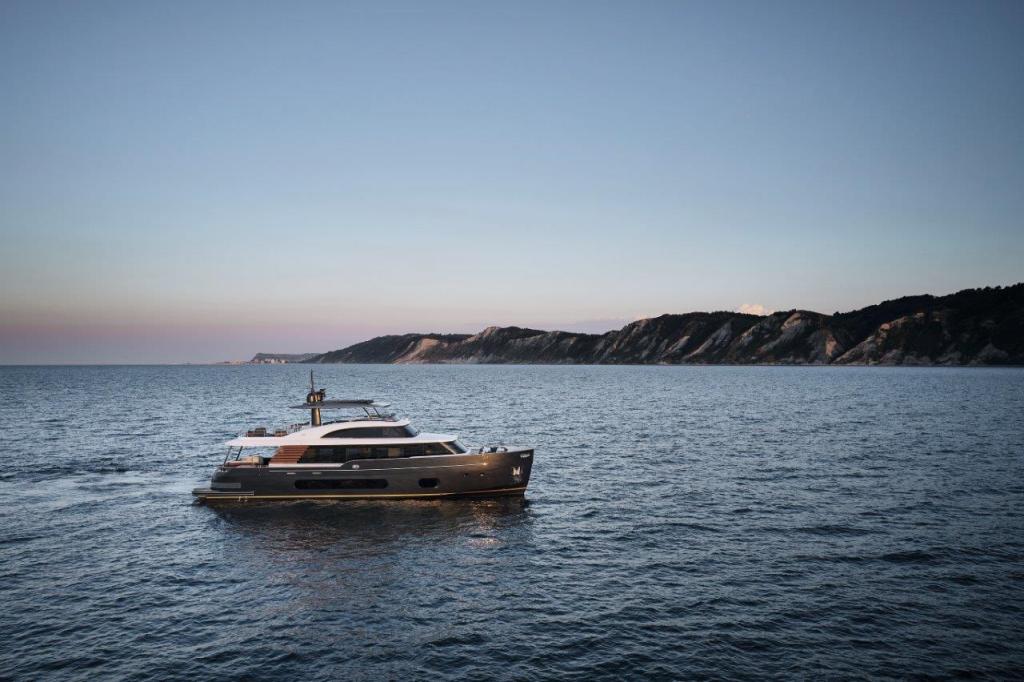
From Superyacht Digest OCTOBER ISSUE 2020
INTERNATIONALLY RENOWNED ARTIST AND ARCHITECT VINCENZO DE COTIIS DEBUTS IN THE NAUTICAL SECTOR INTRODUCING A NEW AESTHETIC DIMENSION IN FULL RESPECT OF THE GREAT HERITAGE OF AZIMUT YACHTS’ MAGELLANO. WITH KEN FREIVOKH BEHIND THE TIMELESS ELEGANCE OF THE CHIC AND SOPHISTICATED EXTERIOR LINES, MAGELLANO 25 METRI HAS BEEN DESIGNED WITH A SPECIAL FUEL-EFFICIENT DUAL MODE HULL.
Known and appreciated all over the world, Architect and Designer Vincenzo De Cotiis debuts in the nautical sector signing the interiors Magellano 25 Metri, part of the Grande collection. In this project he has expressed the characteristic features of his stylistic figure – open spaces, fluid and airy, material contrasts and an unusual and advanced expressive language – preserving the idea that a boat belongs to the sea and not to designer. The main challenge was not to betray the marine character of the boat, that is trying to interpret the nautical object with an ainternationally renowned artist and architect Vincenzo De Cotiis debuts in the nautical sector introducing A NEW AESTHETIC DIMENSION IN FULL RESPECT OF THE GREAT HERITAGE OF AZIMUT YACHTS’ MAGELLANO. with Ken Freivokh behind the timeless elegance of the chic and sophisticated exterior lines, Magellano 25 metri has been designed with a special fuel-efficient Dual Mode hull.rtistic approach without letting art prevail on functionalities and livability on board.
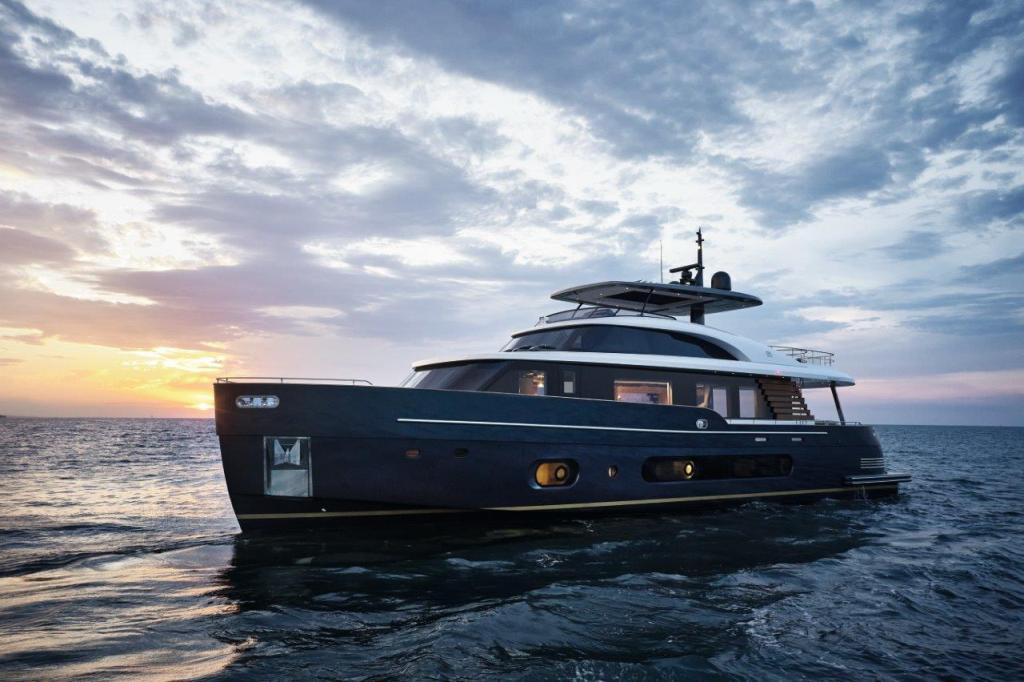
The original, innovative, creative – artistic – approach by Vincenzo De Cotiis Architects has led to the creation of an amazing design project, fully in harmony with the refined and timeless exteriors of the Magellano Collection. The collaboration between Azimut Yachts and Vincenzo De Cotiis Architects marks an important new chapter in the evolution of design on board, giving life to a very original expressive refined language with a great character, which, destined to become a new tendency.
Among the surprise elements, there is the ornamental use of glass fiber, which De Cotiis who is a passionate about new materials, often marked by time and wear, has used for years to create objects with organic shapes and material surfaces. For the first time, therefore, the fiberglass is ennobled and assumes a non-structural but purely decorative function: worked on sight, expresses its raw soul in contrast with decidedly more precious materials, as De Cotiis used to do for his refined works, halfway between art and design.
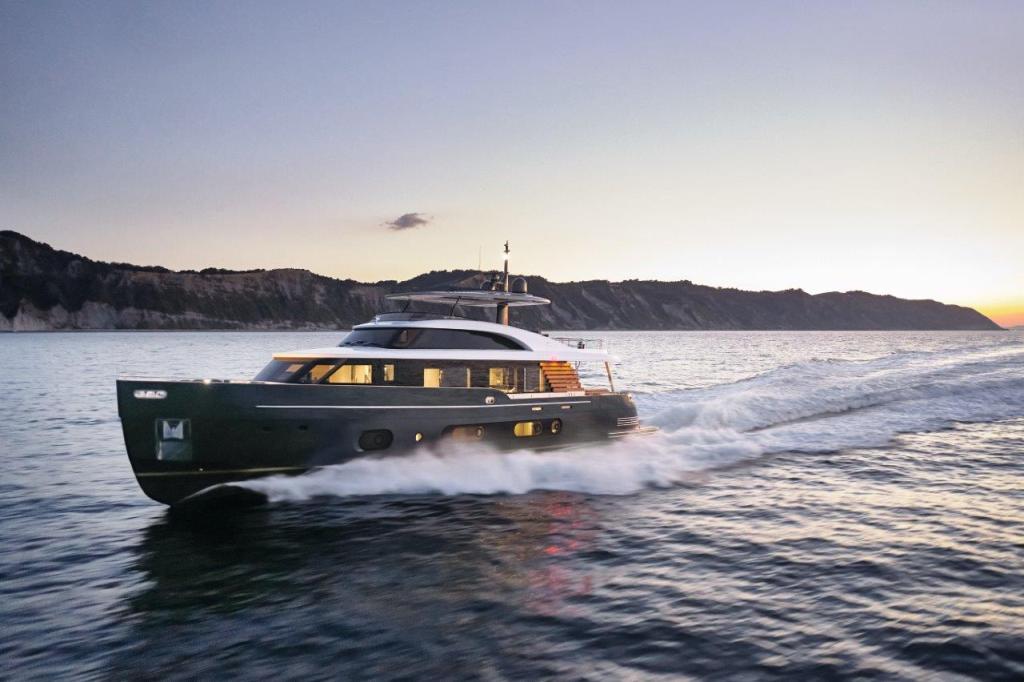
With the aim of tracing a new aesthetic dimension without distorting the functional characteristics of the entire range, De Cotiis has done a skillful job that, having passed the simple furnishing process, has become an articulated architectural project capable of combining aesthetic and stylistic research with the focus on perfect environments for life on-board.The result is an extraordinary layout for a 25-meter boat, which offers great comfort and guarantees absolute privacy between shipping magnate and cabin crew, essential elements for very long cruises, typical of the Magellano fleet.
The partnership with De Cotiis springs from the brand’s desire to reach a new milestone by creating for the first time ever a yacht that isn’t a container for art, but a sea’s work of art.
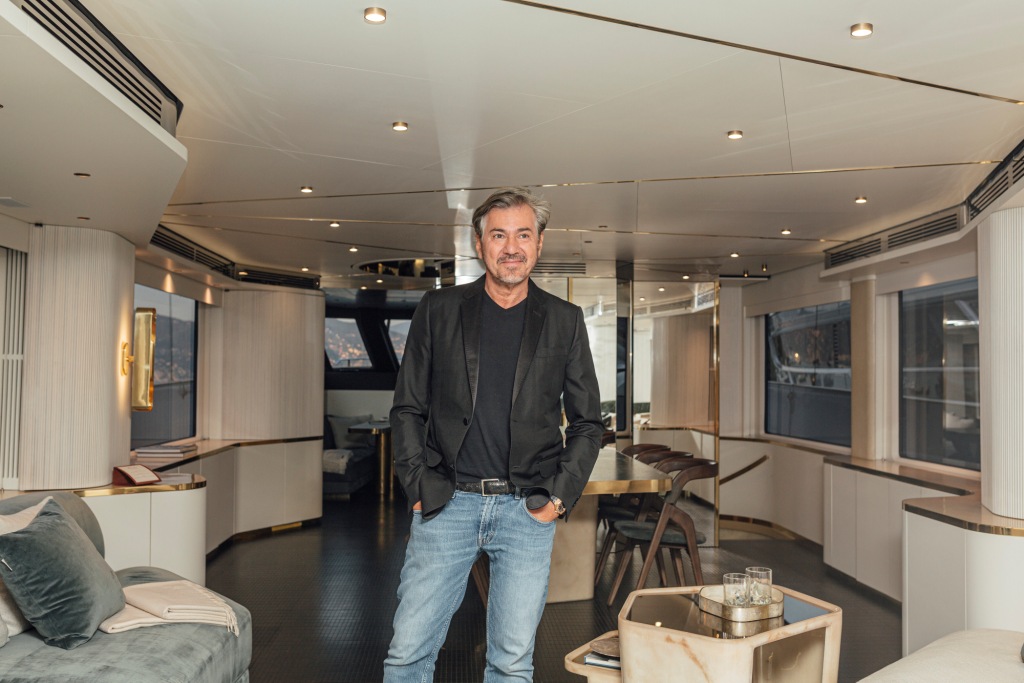
The Vincenzo De Cotiis Architects Firm has worked hard on the perception of the depth of spaces, creating environments without excessive separations, both to allow a continuous visual contact with the sea, both to propose a wider scope than the typical size of a boat. The most strikingly original setting is the huge saloon in which De Cotiis strives to increase the perception of depth. Designed to offer a view of the sea from any point, the space is no longer confined by a classic rectangular floor plan and is flooded throughout with natural light.
With this same purpose, fluid shapes characterize even the furnishings and much attention has been given to create a sense of continuity. The dining table can be arranged lengthwise and the living area is based on the concept of organic geometry, with different shapes sofas that offer different depths. The interior furniture recalls the shape of the dry bar outside creating an indoor-outdoor connection in order to get the sensation of a unified space overlooking the sea. Still on the Main Deck, the stairway is clad with mirrors to “dematerialise” it and, by reflecting the light, the view of the sea became an inner part of the yacht.
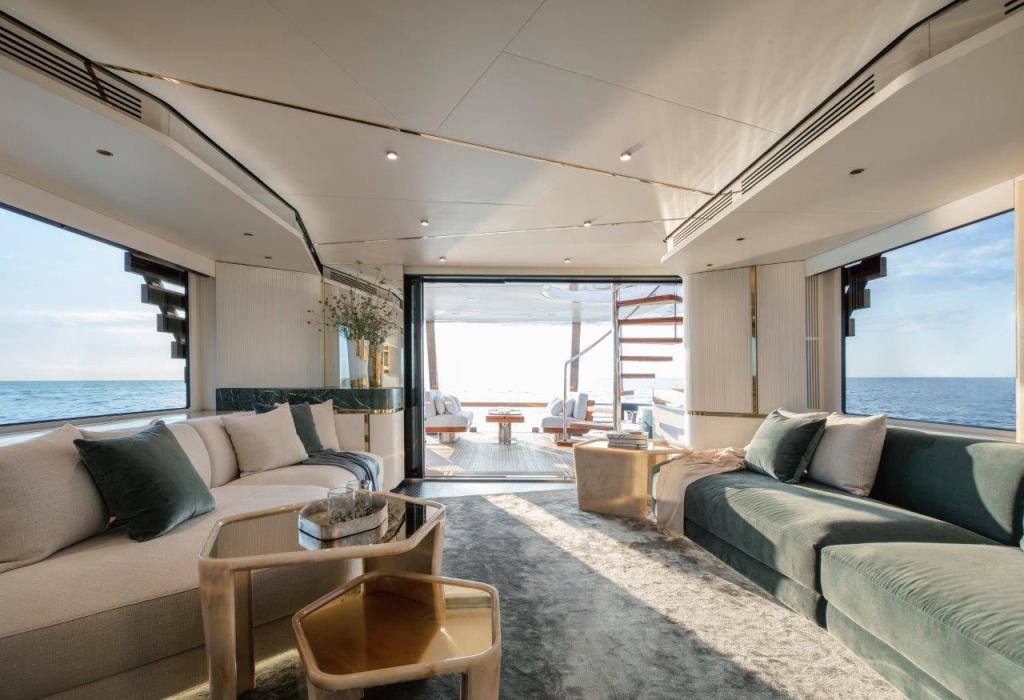
The materials used in the living room area raises on the classical nautical world: wood in lacquered and cannulae version, brass, fiberglass and some mirror inserts. The dunnage is made of wood. The table and other loose furniture items are part of the De Cotiis collection.
The entire environment is characterized with a brass insert that runs along all the surfaces of the yacht accentuating the perception of the curves and outlining the various plans of support in fiberglass while the tall parts are made of cannulae wood, placed vertically in order to enhance the feeling of height. The green upholstery is the only element that adds color in contradiction to the white coverings.
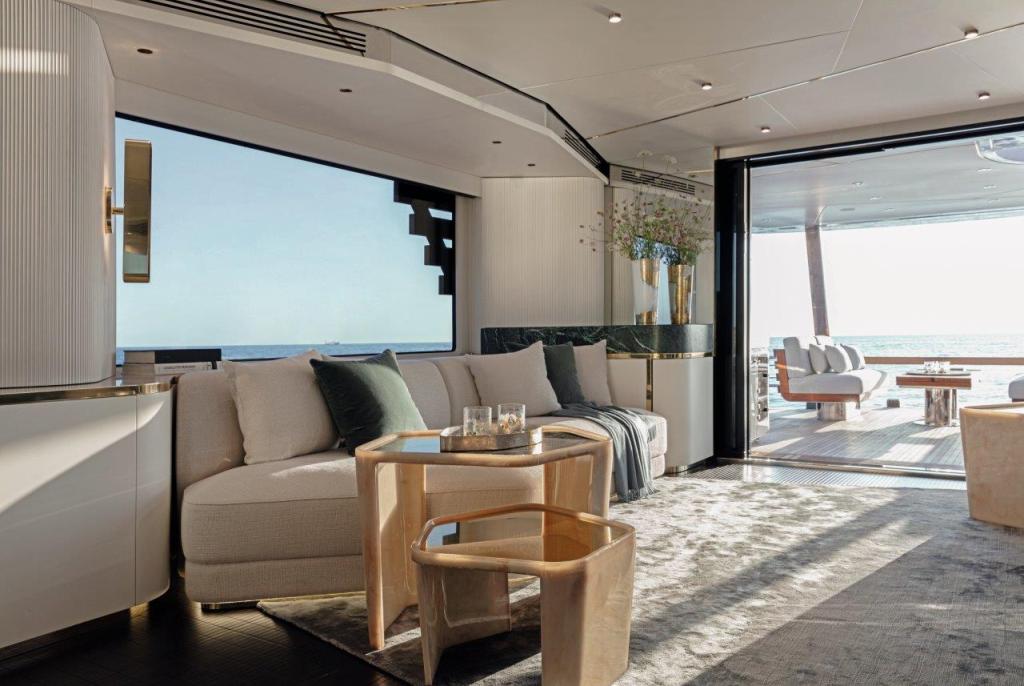
In the night area on the Lower Deck there are four cabins, including two VIPs, one double and one with sliding double beds. In the owner’s suite, thanks to the inclined position of the walk-in closet, the space extends out, while the mirror coating makes the volume disappear and reflects the light and the starboard panorama, creating highly suggestive changing optical effects.
The crew quarters are independent, with direct access from the galley to avoid interference with guests’ movements and ensure a high level of privacy. Magellano 25 Metri is also one of the few yacht in its category to have direct access from the internal wheelhouse, located in a raised position on the main deck, and the external one on the fly so to facilitate the work of the captain and crews.
Artificial light is a key element, with a lighting system designed to create a soft, warm mood. The carefully thought out light design created by the artist involves not only lamps and classic ceiling spotlights, but also and even the sofa bottoms to give the furniture the appearance of “being suspended”.
One of the points of contact with the designer, a leading proponent of collectible art on the international scene, is a shared interest in fiberglass, as an essential construction material for Azimut Yachts and one of the favourite material of the artist. On this yacht fiberglass is given new life as a key element of the design. For Magellano 25 Metri, De Cotiis used a special type of resin and thanks to an elaborate artisanal process, the result of multiple layers and embellished with a bronze powder, he has given life to surfaces of parchment colour, characterized by a pleasant clouded effect and inclusions that in somehow recall those typical of some precious stones.
The “artistic fiberglass” is joined by other materials and types of wood to create a highly appealing play of contrasts: brushed Verde Alpi marble, dark walnut wood, carpet, polished brass, lacquered wood and ribbed wood.
The furnishings feature flowing shapes and a lot of effort has been put into creating a sense of continuity expressed by seamless, curving lines.
Ken Freivokh offers his own personal take on exterior styling based on the concept of timelessness, driven by the desire to create an object of evergreen beauty and appeal, far from fleeting fashions and passing trends.
The central element around which the entire design revolves is the fully-glazed superstructure, created to convey the feeling of a penthouse overlooking the sea. The standout features include the (non-slip surfaces on the transom) wrap-around steel detailing in the stern area and the retro-style windows in the hull. The yacht’s silhouette is given even more personality by the louvers on either side aft of the deckhouse. The elegant spiral staircase leads up to the Fly Deck, where the hard top is supported by a minimalist central mast. The vertical bow underscores the remarkable seaworthiness of this model. While the bow area can be experienced differently, the stern, thanks to a pivoting hatch mechanism, offers the charm of an Infinity Terrace from which to contemplate the charm of the sunset without any visual impediment.
Magellano 25 Metri is a full member of the Carbon Tech Generation and represents another milestone in Azimut Yachts’ pioneering research into the use of a material that offers some undisputed benefits: thanks to a targeted use it is possible to expand the volumes on board while maintaining excellent levels of stability. There has also been a concerted effort to reduce noise and vibration to guarantee the highest levels of comfort; the owner’s suite is set up as a floating capsule and the introduction of an elastic joint between motors and inverters prevents vibrations generated by the propeller axis from propagating inside the boat.
The Dual Mode hull, designed by the firm led by Pierluigi Ausonio, ensures safe and comfortable cruising even in rough seas. The double shaped chine joint with a skeg reduces consumption at different cruising speeds and cushions wave impact. As these features show, Magellano 25 Metri has been designed for long-range cruising even in unfavourable sea and wind conditions.
The yacht is fitted with two MAN engines rated 1,400 horsepower each (or alternatively 1,550 HP), with V-Drive in-line transmission. Stabilization is provided by a Humphree electric fin system. The yacht has a top speed of around 24/25 knots and a cruising speed of 21 knots.
GIOVANNA VITELLI TELLS SYD MORE ABOUT THIS PROJECT AND NEXT PROJECTS
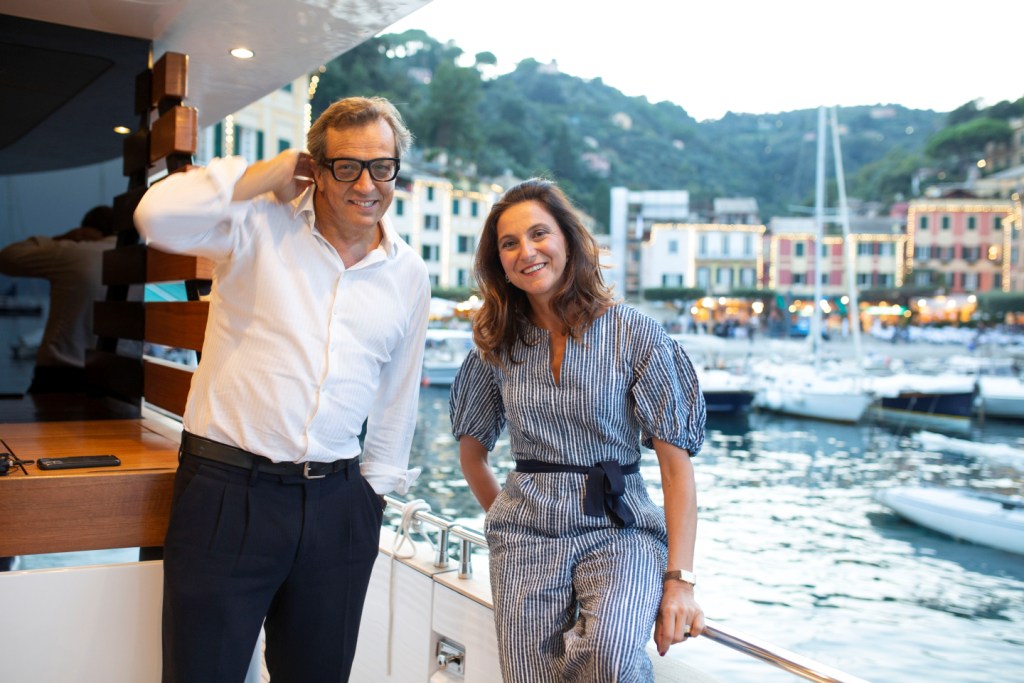
Presented in Portofino in September, in its very first preview, the short film “Open your eyes” celebrates the debut of Azimut Yachts’ new model, the Magellano 25 Metri. Behind the camera is Italian director Gabriele Muccino, who has successfully communicated the fundamental idea that lies at the heart of the Magellano project. The images in fact express how art and beauty can be the spark that brings emotions, and even a new love, to life.
At the Miami Yacht Show last February 2020 we sat down with Giovanna Vitelli, Vice Presidente of Azimut Benetti Group, to talk about this new product. The idea at that time was to present the yacht in Venice during Biennale of Architecture, unfortunately the pandemic changed all the plans. The boat was introduced in Portofino in September at a private event, where the shipyard also announced Marco Valle as new Group CEO, with the aim of creating synergies and developing ever-better efficiencies between the two brands. We also took this opportunity to deepen this project again with the management.
SD: “With the interchange between art, yachting and design, which you have been introducing for some time with Azimut Yachts, you have started a new process of modernization in boating, trying to change the order of things and bringing innovation. What do you gather from this experience, what reflection have you made?”
GV: “This experience led us towards the desire for novelty. Boating was still too tied to old – outdated – schemes, both in terms of space distribution and in stylistic and decorative terms. On the one hand, the need to propose something different was deeply felt inside our company, on the other hand the sector was demanding a sort of change. We were referring to an audience with a language that was no longer adequate to their current lifestyle; the habits of our customers were changing, not only because over the years their lifestyle evolved, but because generations are changing, and consequently, we need to renew ourselves. We are not new to the exeperience of contamination between art and design. This approach we have already tested has led us to a further step and to the decision to involve a name like De Cotiis for the interior design of the new Magellano 25 Metri”.
SD: “Why did you choose this boat as your new frontier for design experiments?”
GV: “Because the Magellano was historically born with the mission of revolution-evolution. When we designed it in 2007, before launching it on the market two years later, we wondered if customers, in the near future, would continue to be attracted by speed, traditional flybridge, glamorous and sexy aspects of the yachting lifestyle, or if, instead, they would have changed their habits developing a different way to go to sea. For example, living the sea as a sea dog, a sailor who gives much more importance to the journey and less to the destination, who loves comfortable and intimate spaces because the time to spend on board will be long. We therefore tried to create a new product by applying the logic of the trawler.
The Magellano was born with the idea of being a niche product, it ended to be a great satisfaction also in commercial results. In the end, investing in new solutions has proved us right! The Magellano was the first crossover in the small boat segment. Even today this category, in all its forms, is the one that is performing best on the market, the Magellano can be considered the first model in history. Thanks to the important contribution in the development of boating, and for being recognized as a very innovative boat, we have chosen the Magellano as a model with which to try to go further by offering new visions. We thought of involving an architect who was a signature that could lead to the creation of a real work of art”.
SD: “These contaminations contribute to enrich the product and to bring new values, are there, however, some limits that can not be overcome?”
GV: “Yes, absolutely, there is a very clear limit, and for this reason our search for contamination and dialogue with architects outside the nautical world has been very long, broad and complex. We spoke with many architects before deciding for De Cotiis; he is one of the very few architects outside our sector, who is able to bring his ideas while respecting the boat as an object of the sea, without considering it as an exhibition space and without bending it to the needs of the design object. A boat is not a New York apartment, it must always remain in dialogue with the environment to which it belongs, its architecture must suggest its use and dialogue with the sea in aesthetic and functional terms. De Cotiis’ approach was not to create special spaces to host works of art, if that had been the case we would not have been able to define this boat as an artwork. The stylistic-artistic characteristic of De Cotiis lies in the contrast between rich and poor materials, which find their most extreme expression with fiberglass, a material that he prefers in many of his works. We gave him carte blanche, while collaborating in certain aspects that as a construction site we know should not be touched. The project stems from a conversation with him around the concept of a somewhat retro boat, to which to give a contemporary allure, and the stylistic-artistic element on this specific unit is exceptional and captivating and helps us to carry on a story of innovation that began with the first model ten years ago”.
SD: “After your big event in New York last year in May, what should we expect now in terms of new marketing initiatives?”
GV: “We never stop, this year the biggest launch is represented by the Magellano 25 Metri. We planned to present the boat in Venice with an event during the Architecture Biennale but, you know, what has happened globally. Due to the pandemic we had to change all plans. This year started with a great success. We can count ourselves fortunate that in February we could launch the Verve 47 in great style with an event at the Miami Yacht Show, launch which incredibly exceeded all our expectations. We wanted to challenge the American market by bringing a 47-foot outboard, a real mission for an Italian brand. This boat has an extremely revolutionary hull for an outboard and boasts a layout that combines the funniest – enjoyable – aspect and the practical sense of those who know boats well, and the American people know them very well, that’s why the boat has had a lot of success. This year marks another milestone for our group, we have just presented the first Benetti Oasis 40m in Portofino, whose sales results are currently very satisfying”.
SD: “In 2019 you celebrated your 50th year of activity for the Azimut Yachts brand, you have reached an important stage. What do you expect from the next decades?”
GV: “A new era will open but we do not expect major revolutions. It will open for various reasons, first of all we are witnessing a generational shift that does not only concern the family change at ownership level, but also the designers’ world, and in fact we have new collaborations with new names for new products. A third aspect concerns a change in the way of thinking; boating has been evolving, this already happens for some years, and it will evolve more and more in favour of eco-sustainability and those new themes that can be more attractive for the new generation of yacht owners. We are studying new lifestyles and developing strategies to be able to approach them with greater interest. Both our products and the target customers are the subject of our continuous brainstorming sessions; for sure, the DNA of our company, philosophy, ethics, those will not change”.
SD: “Every new path needs a phase of elaboration and thinking first and, secondly, experimentation, what are you thinking about today?”
GV: “Yes, that’s correct, this change we are facing fuels our need to experiment, which is the real big issue today. A major theme that is still at the center of our experimentation is the diesel-electric engine. If we think that this has not yet expanded in the automotive sector, we can imagine that boating requires more time and more research. That said, as a company we are required to initiate experimentation processes that lead to real innovations in this sense. We are experimenting in this direction and we are doing it not from a marketing perspective but for real product development. The outboard segment interests us a lot, with the Verve 47 we tried to enter the market, now we will develop new models. Azimut Yachts traditionally follows the philosophy of experimentation; we have always had the desire to understand new social dynamics that allow us to intercept new models of life and style”.
SD: “Today the boat plays on several aspects at the same time: large outdoor spaces, greater internal comfort, elegance, flexibility, versatility, design, style, and then, behind the scenes, all the contents related to innovation and technology. Are all of these aspects together necessary to attract the customer?”
GV: “First of all, we must make a very important distinction between all these things: innovation and technology are essential ingredients and they must not be linked with the rest, they stand alone, that is, they are key aspects of the product development area. All other themes, which marketing actions are used to put together like a cocktail, play more on an emotional level on the customer, have less substance, are more part of promotion operations, are useful levers to be able to tell the story of the boat. I think that experimentation must focus on one or part of these aspects; each product will then have its own DNA as distinguishing element, such as Magellano 25 Metri with the interiors by De Cotiis. The right question to ask about this project is ‘Can art come on board and be a tool for enhancing space, without being an end in itself on the one hand and respectful of the object in which it is inserted on the other?’. This is an experience that we have started for some time, already with architect Achille Salvagni: we have created very disruptive lines by breaking the mold of yacht design, and the market has proved us right, it has been a great success. We worked by focusing on one of all aspects, a sinuous design in line with the marine environment. Today Salvagni still collaborates with us on the Flybridge range from 60 feet upwards. Our collaboration has always been a path of ideas shared together, he was chosen at the beginning because we had glimpsed a certain genius in him; even though he came from the residential area, he looked at the boats with respect. His shapes and lines arise from the idea of the fluidity of the object evoking a sense of calm, which is precisely what belongs to nature by definition”.
SD: “Fashion and sometimes also design are used to take their inspirations from the past. In boating this does not happen, what do you think?”
GV: “It’s true, and it is a very interesting aspect. In our sector, there is no such trend. However, if we look at our approach, this theme involves us a lot. Many fashion companies very often open historical archives to celebrate their tradition and their history as evidence of the great contribution they have made to their sector. We are doing this exercise with Benetti”.
“We want to bring to light all our evolution, our archive will be a reference center for documentation on boat styles and concepts that belonged to the past: we believe these are worth finding and revisiting in a modern way in order not to lose them but on the contrary to save them as heritage. We found that even in the customer there is a certain desire to return to the past. B.Yond, Benetti’s new expedition line, is a return to origins. The use of steel is in the DNA of Benetti history. As for Azimut Yachts, the Magellano 25 Metri will already be an example of this exercise we are doing. The boat evokes the retro taste of boating, reinterpreting it in a contemporary key. However, we must also say that this exercise in analyzing the past was also done through the work of architect Stefano Righini, with his study of proportions and volumes. Today designer Alberto Mancini continues this work of analysis of the past for Azimut, focused on harmonic balances. I personally agree, it is essential to look at tradition”.
SD: “With the collaboration with De Cotiis, you introduce, for the first time in the nautical world, the concept of ‘preciousness’, that is environments in which the refined material – marble and brass – is even more exclusive thanks to the contrast with raw materials such the fiberglass used as an element of decoration. Looking at the market, are customers really interested in these style proposals or are they influenced by marketing campaings?”
GV: “De Cotiis is a lover of a principle that in my opinion is extremely nautical, namely the ‘uniqueness of creation’. A value shared by our customers, who interpret uniqueness as one of the ways of understanding luxury. The serial product is not for them. De Cotiis works very well on proposals exclusively designed for the individual client and has a very opulent sense of decoration. He has been able to create a transversal project, I mean, a boat that the customer is not obliged to choose with all the details and decorations proposed by De Cotiis in the first unit, but has the freedom to ask for different elements. The architectural project is valid for this reason, its value lies in the management of the spaces the architect has been able to create and in the interesting architectural vision he has offered”. As a shipyard, we must be very careful that these collaborations do not become sterile style exercises, or collaborations that do not reflect the interest of the market. The Magellano 25 Metri by De Cotiis proved to be the right choice, if we consider that all the units sold so far have his interiors, even if some elements have been changed. But this means that the project works even without all the elements proposed”.
SD: “The boat is an expression of joy, of life, in what form was De Cotiis able to express this emotion?”
GV: “I believe that this explosion of preciousness linked to the contrasts makes the space on board a very fascinating place. De Cotiis has a past experience in retail and this is a very interesting aspect, it allowed him to develop the ability to create unique languages for the wider market. The poetic with which he creates the interiors is a vision of well-being and joy because in this project he tried to bring out the soul from every aspect. We really enjoyed working with him, he is an important signature that we also wanted to involve on a second project, the Azimut Magellano 30 Metri”.
Read it on ISSUU: click on cover



